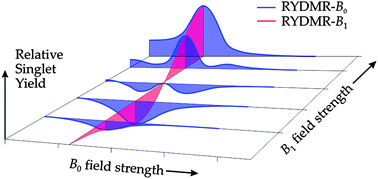Spin-locking in low-frequency reaction yield detected magnetic resonance†
Abstract
The purported effects of weak magnetic fields on various biological systems from animal magnetoreception to human health have generated widespread interest and sparked much controversy in the past decade. To date the only well established mechanism by which the rates and yields of chemical reactions are known to be influenced by magnetic fields is the radical pair mechanism, based on the spin-dependent reactivity of radical pairs. A diagnostic test for the operation of the radical pair mechanism was proposed by Henbest et al. [J. Am. Chem. Soc., 2004, 126, 8102] based on the combined effects of weak static magnetic fields and radiofrequency oscillating fields in a reaction yield detected magnetic resonance experiment. Here we investigate the effects on radical pair reactions of applying relatively strong oscillating fields, both parallel and perpendicular to the static field. We demonstrate the importance of understanding the effect of the strength of the radiofrequency oscillating field; our experiments demonstrate that there is an optimal oscillating field strength above which the observed signal decreases in intensity and eventually inverts. We establish the correlation between the onset of this effect and the hyperfine structure of the radicals involved, and identify the existence of ‘overtone’ type features appearing at multiples of the expected resonance field position.


 Please wait while we load your content...
Please wait while we load your content...